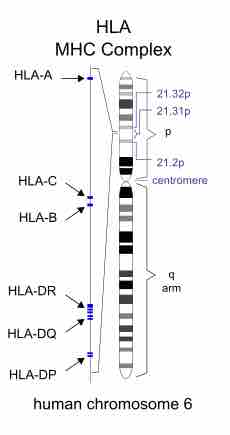Major histocompatibility complex (MHC) is a cell-surface molecule encoded by a large gene family in all vertebrates. MHC molecules display a molecular fraction called an epitope and mediate interactions of leukocytes with other leukocytes or body cells.
The MHC gene family is divided into three subgroups—class I, class II, and class III. Diversity of antigen presentation, mediated by MHC classes I and II, is attained in multiple ways:
- The MHC's genetic encoding is polygenic,
- MHC genes are highly polymorphic and have many variants,
- Several MHC genes are expressed from both inherited alleles (variants).
MHC gene families are found in all vertebrates, though they vary widely. Chickens have among the smallest known MHC regions (19 genes).
In humans, the MHC region occurs on chromosome 6 . Human MHC class I and II are also called human leukocyte antigen (HLA). To clarify the usage, some of the biomedical literature uses HLA to refer specifically to the HLA protein molecules and reserves MHC for the region of the genome that encodes for this molecule, but this is not a consistent convention.

HLA MHC complex
The human leukocyte antigen (HLA) system is the name of the major histocompatibility complex (MHC) in humans. The super locus contains a large number of genes related to immune system function in humans. This group of genes resides on chromosome 6, encodes cell-surface antigen-presenting proteins and has many other functions.
The most intensely-studied HLA genes are the nine so-called classical MHC genes: HLA-A, HLA-B, HLA-C, HLA-DPA1, HLA-DPB1, HLA-DQA1, HLA-DQB1, HLA-DRA, and HLA-DRB1. In humans, the MHC is divided into three regions: classes I, II, and III. The A, B, C, E, F, and G genes belong to MHC class I, whereas the six D genes belong to class II. MHC genes are expressed in co-dominant fashion. This means that the alleles inherited from both progenitors are expressed in an equivalent way. As there are 3 Class-I genes, named in humans HLA-A, HLA-B and HLA-C, and as each person inherits a set of genes from each progenitor, that means that any cell in an individual can express 6 different types of MHC-I molecules.
In the Class-II locus, each person inherits a couple of genes HLA-DP (DPA1 and DPA2, which encode α and β chains), a couple of genes HLA-DQ (DQA1 and DQA2, for α and β chains), one gene HLA-DRα (DRA1) and one or two genes HLA-DRβ (DRB1 and DRB3, -4 o -5). That means that one heterozygous individual can inherit 6 or 8 Class-II alleles, three or four from each progenitor.
The set of alleles that is present in each chromosome is called MHC haplotype. In humans, each HLA allele is named with a number. Each heterozygous individual will have two MHC haplotypes, one in each chromosome (one of paternal origin and the other of maternal origin).
The MHC genes are highly polymorphic; this means that there are many different alleles in the different individuals inside a population. The polymorphism is so high that in a mixed population (non-endogamic) there are not two individuals with exactly the same set of MHC genes and molecules, with the exception of identical twins.
The polymorphic regions in each allele are located in the region for peptide contact, which is going to be displayed to the lymphocyte. For this reason, the contact region for each allele of MHC molecule is highly variable, as the polymorphic residues of the MHC will create specific clefts in which only certain types of residues of the peptide can enter. This imposes a very specific link between the MHC molecule and the peptide, and it implies that each MHC variant will be able to bind specifically only those peptides that are able to properly enter in the cleft of the MHC molecule, which is variable for each allele. In this way, the MHC molecules have a broad specificity, because they can bind many, but not all, types of possible peptides.
The evolution of the MHC polymorphism ensures that a population will not succumb to a new pathogen or a mutated one, because at least some individuals will be able to develop an adequate immune response to win over the pathogen. The variations in the MHC molecules (responsible for the polymorphism) are the result of the inheritance of different MHC molecules, and they are not induced by recombination, as it is the case for the antigen receptors.
Because of the high levels of allelic diversity found within its genes, MHC has also attracted the attention of many evolutionary biologists.